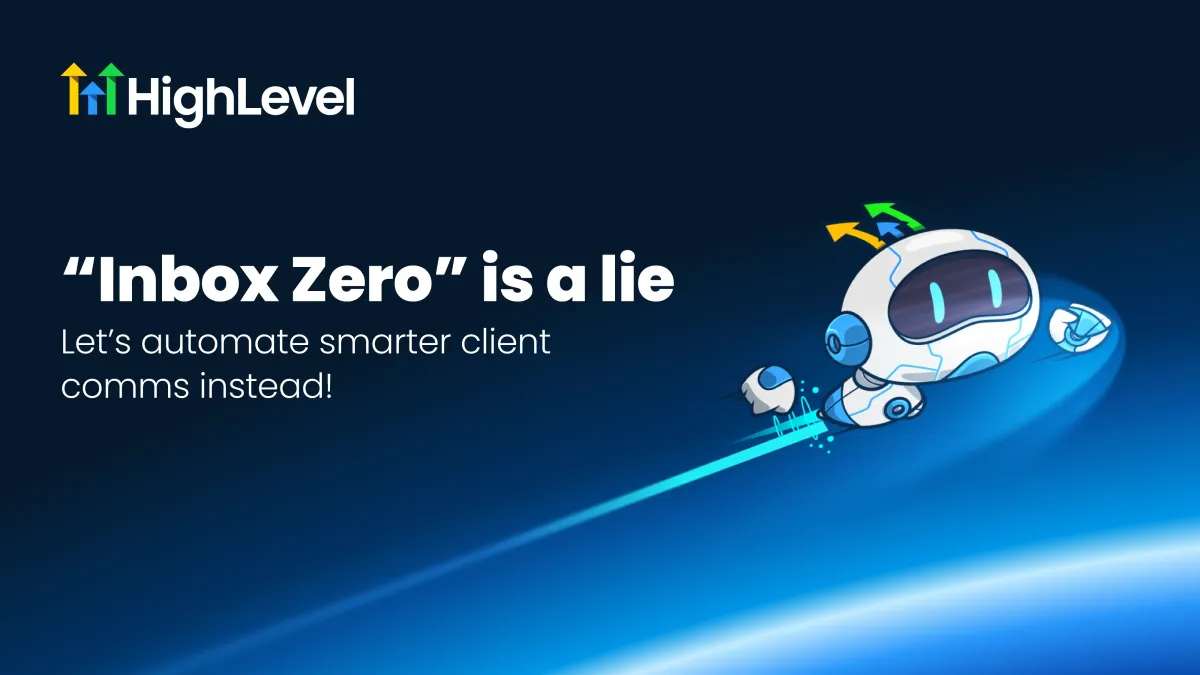
Inbox Zero is a lie: Let’s automate smarter client comms instead
According to research, the average professional spends more than 3 hours a day checking work email and that doesn’t include texts, DMs or CRM messages.
Agencies often spend even more, juggling multiple inboxes for clients, campaigns and support.
That’s why so many teams chase Inbox Zero: the idea that if you clear your messages fast enough, you’ll finally be caught up.
But the truth is: the messages never stop coming.
The solution isn’t another productivity hack or batch-reply system. It’s building client communication automation that responds faster, smarter and with more consistency than any human could manage manually.
In this guide, we’ll cover:
Why Inbox Zero was never the real goal.
What’s actually broken in agency communication.
How to use HighLevel email workflows and AI tools to streamline client comms.
Real strategies to balance personalization and automation.
And how to build scalable communication systems inside HighLevel CRM.
Let’s move beyond inbox maintenance and start designing communication that runs itself!
Why Inbox Zero doesn’t work (and was never the real goal)
Inbox Zero started as a time management philosophy.
The goal: keep your inbox empty so you’re always “on top” of communication.
But modern agency life doesn’t fit that framework. Between leads, clients, team threads and notifications from every app imaginable, inboxes have become the digital version of a waiting room that never clears out.
The real issue actually is how much time you spend responding manually.
Even when you reach Inbox Zero, it rarely lasts.
Messages flood back in within hours, forcing you to repeat the same tasks: reply, forward, follow up, copy notes into the CRM and hope you didn’t miss anything.
This means the actual problem here is that, more often than not, agencies tend to engage in reactive communication.
And that’s exactly what automation is designed to fix.
The real problem: reactive communication that wastes time
Reactive communication is when you spend your day responding to everyone else’s priorities instead of your own.
For agencies, that often looks like:
Following up with leads who never replied.
Sending manual updates to clients after every milestone.
Checking multiple inboxes for messages that could’ve been routed automatically.
Copying email threads into the CRM by hand.
These small tasks compound quickly. Over time, they drain hours from your schedule and create inconsistency in client experience.
Automation doesn’t just save time, it creates reliability.
When every client receives the same timely updates, every lead gets the same follow-up and every inquiry is routed correctly, your agency becomes easier to trust.
Smart automation ≠ spam: how to personalize without the pressure
One of the biggest misconceptions about email automation for agencies is that it sacrifices personalization.
But the best CRM communication tools do the opposite. Automation gives you more control over when and how you reach out, without losing your tone or context.
Here’s how to make it feel human:
Segment by behavior
Use HighLevel’s CRM automation to trigger different messages based on what your clients or leads actually do.
Opened your proposal but didn’t book? Send a reminder with new availability.
Missed an appointment? Trigger an automatic reschedule link.
Completed a campaign? Send a short “thank you” message and next-step survey.
Write once, customize always
Create message templates that use dynamic fields (like name, company or service type). AI for email replies can even rewrite subject lines and body text to match tone and urgency automatically.
Automate the handoff
Route messages to the right team member with smart email routing. HighLevel can detect topic keywords or form inputs and assign them to the right workflow, so client issues don’t sit unaddressed.
Build check-in sequences
Not every touchpoint should be a pitch. Schedule automated “just checking in” messages to maintain relationships between projects.
Automation isn’t about removing the human element; it’s about designing it once and delivering it consistently.
Using HighLevel to automate client emails, texts and check-ins
The reason HighLevel CRM stands out is that it connects every part of communication, email, text, call and chat, inside one system. You don’t need separate apps for follow-ups, reminders or updates.
Here’s how to automate your entire client communication flow:
1. Create a communication workflow
Go to Automation → Workflows in HighLevel.
Choose triggers that start each message sequence, such as:
“Form Submitted”
“Appointment Booked”
“Pipeline Stage Changed”
“Tag Added (Client Onboarding)”
Add actions like “Send Email,” “Send SMS,” or “Wait 1 Day.” You can stack as many as needed to create a complete journey.
2. Use Content AI to write messages faster
Inside any workflow step, open Content AI to draft or refine your copy.
Prompt it with details like:
“Write a friendly reminder email for clients who missed an appointment.”
AI will then generate a message you can personalize further before publishing. This tool saves time while keeping your brand’s tone consistent across all communication.
3. Automate follow-ups across channels
Use HighLevel’s automated client follow-ups to reach contacts by email, SMS or even voicemail.
Example:
Day 1: “Thanks for your interest, here’s your next step.”
Day 3: “Still interested? Schedule a quick call.”
Day 5: “We’d love your feedback. Is now a better time?”
Each message adapts based on response; if someone replies, the sequence stops automatically.
4. Connect workflows to your CRM data
Because HighLevel’s automation is built into the CRM, every conversation updates contact records automatically.
Tags, pipeline stages and lead scores adjust in real time, giving you full visibility into who’s engaged and who needs attention.
5. Schedule recurring client updates
You can also create HighLevel email workflows for ongoing communication, weekly reports, campaign updates or renewal reminders.
Use date-based triggers like “Every Monday at 9 AM” or “14 days before contract renewal.”
The result is predictable communication that doesn’t rely on memory or manual effort.
Building smarter client communication systems
The most successful agencies treat automation as part of their communication strategy, not a separate function.
Here’s what that looks like in practice:
One system of record: Emails, texts and notes all live in HighLevel, so your team sees the full conversation history.
Defined workflows: Each type of client message (lead nurturing, onboarding, reporting) has its own automated process.
Ongoing optimization: Review workflow analytics monthly. See which emails get the most responses and adjust your timing or tone accordingly.
AI assistance where it counts: Use AI email assistant tools to summarize threads, draft responses and suggest follow-ups.
When communication becomes predictable, your agency gains two things: time and trust.
Clients don’t wonder when they’ll hear from you next and your team doesn’t spend hours searching for the last email.
Why HighLevel makes communication automation easier
There are dozens of automation tools on the market, but HighLevel CRM automation stands apart because it connects every channel natively.
Centralized inbox: Manage all client messages, email, SMS, chat, from one dashboard.
AI-driven writing tools: Generate, edit and personalize communication in seconds.
Smart routing: Assign incoming messages to the right team automatically.
Scalable templates: Clone workflows across accounts or clients in one click.
Analytics and reports: Track delivery rates, responses and engagement inside the same platform.
For agencies juggling multiple clients, this integration replaces half a dozen separate apps with one connected system.
It’s not about clearing your inbox. It’s about never needing to.
Conclusion: replace inbox stress with AI-powered, strategic comms
Inbox Zero was a noble goal when communication happened in one place.
Today, it’s an outdated measure of success.
Your real metric should be response reliability, how consistently your business communicates across every client, lead and channel.
With HighLevel email workflows and AI CRM tools, you can build that consistency once and let automation handle the rest.
Every message finds the right person. Every client gets a timely update. Every team member stays in sync.
If you’re ready to stop chasing your inbox and start designing smarter communication systems, try HighLevel free for 14 days.
See how automation turns reactive messages into proactive relationships and how you can white-label HighLevel to offer the same efficiency to your clients. Better communication doesn’t come from faster replies. It comes from systems built to deliver them automatically!
FAQs
What is Inbox Zero and why doesn’t it work anymore?
Inbox Zero is the idea of keeping your inbox completely empty by replying to every message immediately. It doesn’t work today because communication happens across multiple channels and manual responses can’t scale.
How can AI help manage client communications better?
AI tools like HighLevel’s Content AI and Workflow AI can draft replies, build message sequences and route emails to the right person automatically.
Can I automate client emails without sounding robotic?
Yes. Use personalized templates, dynamic fields and behavior-based triggers so each message feels intentional and relevant.
What tools in HighLevel help with communication automation?
Workflows, Content AI, unified inbox and calendar integrations are all designed to automate client communication across channels.
Is it safe to automate replies to leads and clients?
Absolutely. You can control which messages are automated and set conditions to pause automation when a client replies or when escalation is needed.
How do I balance personalization with automation?
Build automations that reference client data and timing, not generic templates. Review message tone regularly to ensure it matches your brand.
Will automation reduce client satisfaction?
No. Consistency and responsiveness often increase satisfaction, as long as automations are personalized and well-timed.
How do I set up communication workflows in HighLevel?
Go to Automation → Workflows and create triggers for key actions like form submissions, bookings or status updates. Add your email or SMS steps and connect them to your CRM records for real-time tracking.

